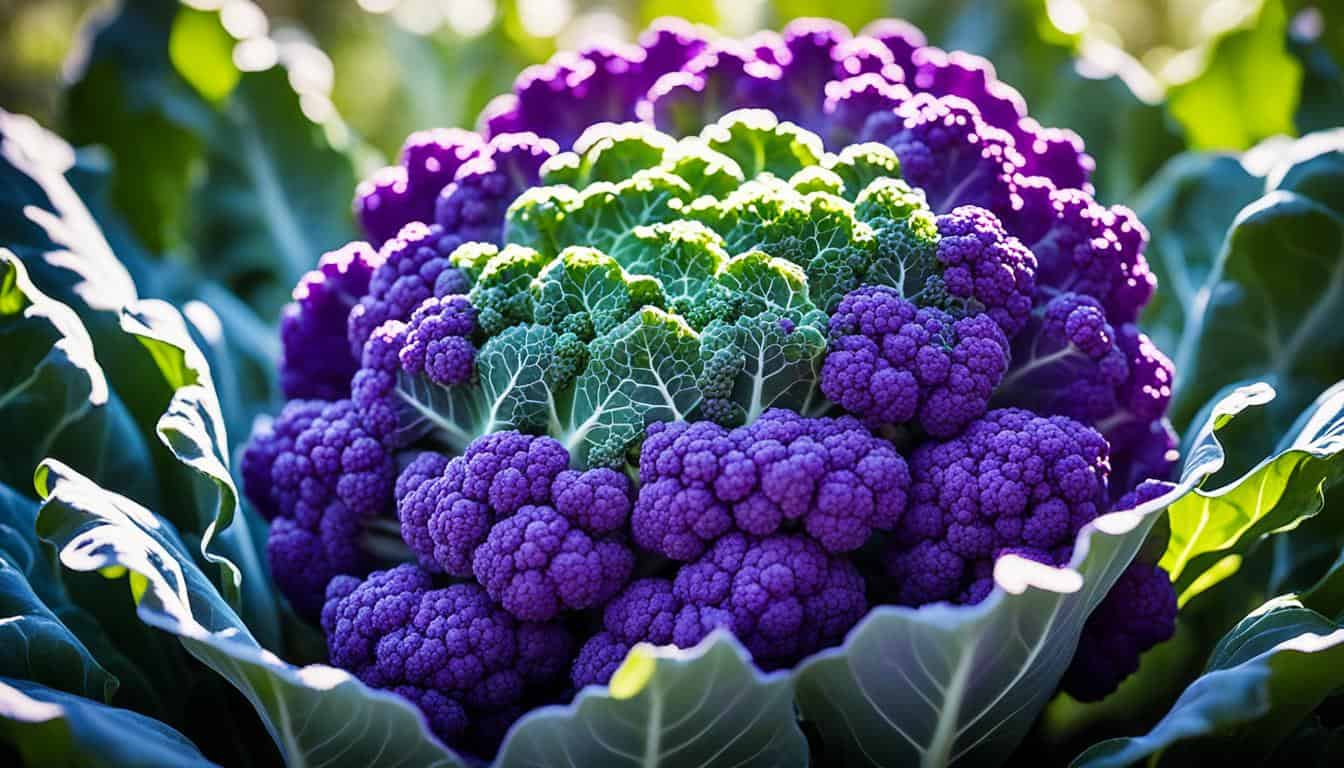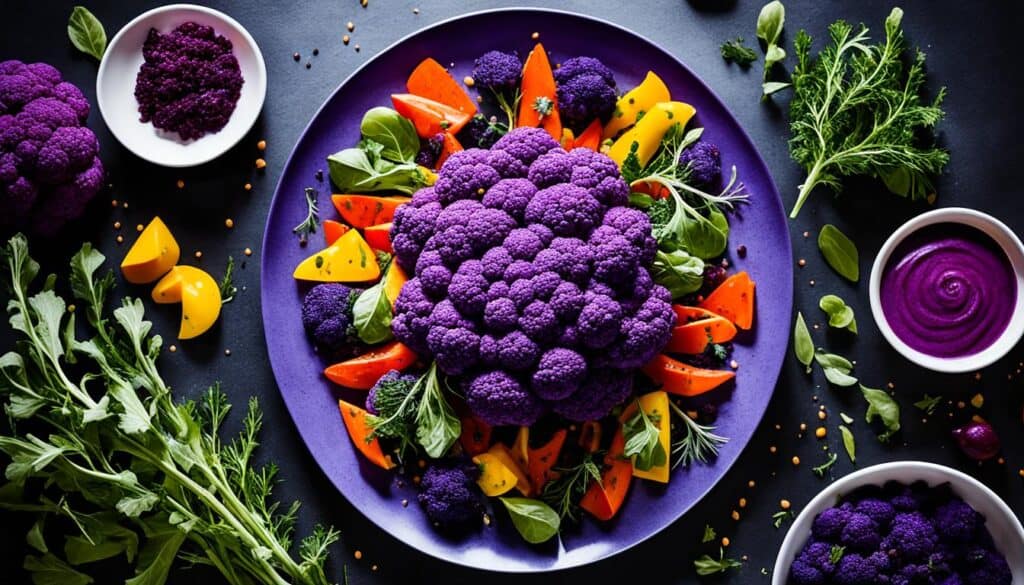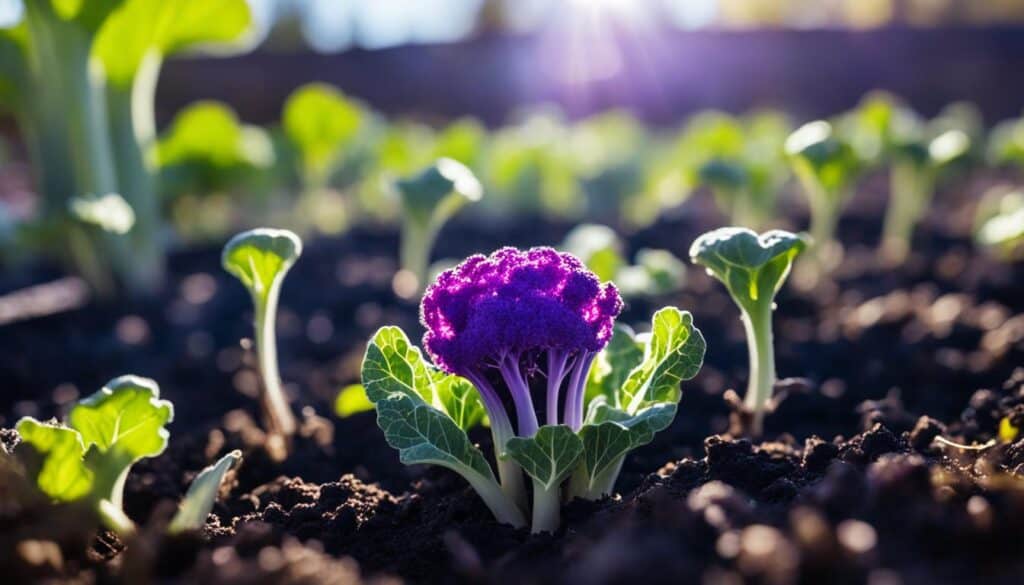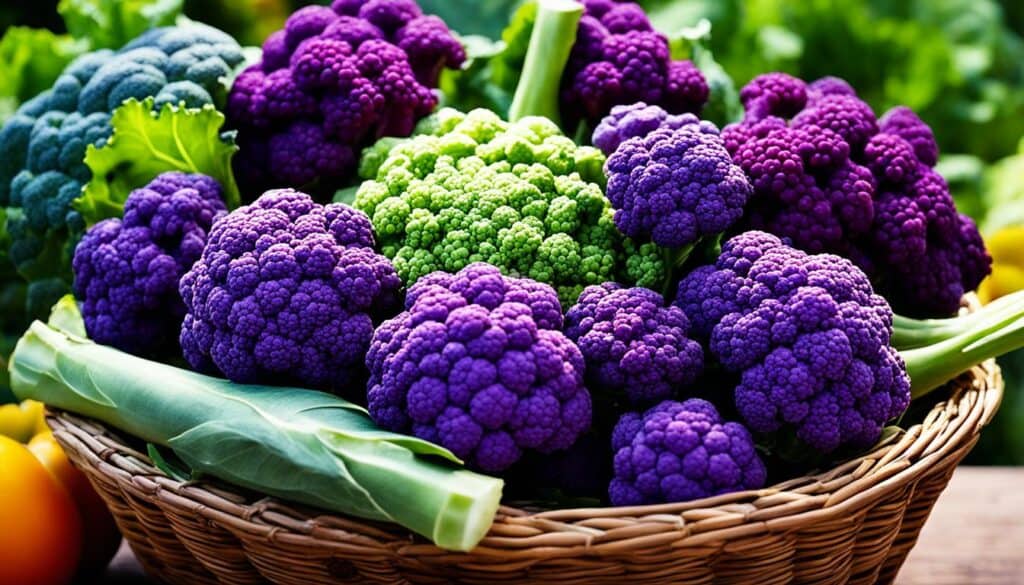Did you know that purple cauliflower is not just a visually stunning vegetable, but it also offers a range of health benefits? This vibrant and unique variety of cauliflower is gaining popularity for its eye-catching color and delicious flavor. In this article, we will explore the fascinating world of purple cauliflower, including its nutrition, health benefits, and even how to grow it at home! Get ready to indulge in the allure of purple cauliflower and unlock its potential in your culinary adventures.
Key Takeaways:
- Purple cauliflower is a visually stunning vegetable with a range of health benefits.
- It is rich in antioxidants, vitamins, and minerals, making it a nutritious addition to your diet.
- Purple cauliflower can be used in various recipes, from roasted steaks to colorful vegetable platters.
- You can grow purple cauliflower at home with proper care and attention.
- Incorporating purple cauliflower into your meals adds flavor and a pop of color to your dishes.
What is Purple Cauliflower?
Purple cauliflower is not your average cauliflower. It stands out with its vibrant purple hue, which is caused by the antioxidant anthocyanin. This same compound is found in red wine and gives purple cauliflower its unique color and charm. Unlike its white counterpart, purple cauliflower offers a sweeter, nuttier flavor profile, making it a delightful addition to any dish.
There are several varieties of purple cauliflower, each with its own distinct shade and characteristics. From deep eggplant purple to lighter lavender tones, these variations add visual interest and diversity to your meals.
Health Benefits of Purple Cauliflower
Purple cauliflower not only adds a burst of vibrant color to your plate but also provides a multitude of health benefits. Rich in antioxidants, vitamins, and minerals, purple cauliflower offers a nutritious addition to any diet. Let’s take a closer look at some of the key health benefits it offers:
Antioxidant Powerhouse
Purple cauliflower is packed with antioxidants, including anthocyanins, which give it its beautiful purple hue. These antioxidants neutralize harmful free radicals in the body, reducing oxidative stress and protecting against chronic diseases like heart disease and certain types of cancer.
Inflammation Reduction
The anthocyanins found in purple cauliflower have anti-inflammatory properties, helping to reduce inflammation in the body. Chronic inflammation is linked to various health problems, including cardiovascular disease, arthritis, and autoimmune disorders. Adding purple cauliflower to your diet can contribute to a healthier inflammatory response.
Heart Health Support
The anthocyanins in purple cauliflower are also beneficial for heart health. They help to improve blood circulation, reduce the risk of blood clots, and lower blood pressure levels. By including purple cauliflower in your meals, you can enhance your cardiovascular wellbeing and maintain a healthy heart.
Nutrient-Rich
Along with its vibrant color, purple cauliflower is a nutrient powerhouse. It is an excellent source of fiber, which aids digestion and promotes bowel regularity. Purple cauliflower also provides essential vitamins and minerals, including vitamin C, vitamin K, and folate.
Did you know? Purple cauliflower contains about 75% of the recommended daily intake of vitamin C per serving!
Eye Health Support
Purple cauliflower contains lutein and zeaxanthin, two powerful antioxidants that are beneficial for eye health. These compounds help to protect the eyes from oxidative damage, reduce the risk of age-related macular degeneration, and maintain good vision.
To fully appreciate the nutritional value of purple cauliflower, take a look at the table below, which highlights its key vitamins and minerals:
| Nutrient | Amount per Serving (1 cup, chopped) |
|---|---|
| Vitamin C | 70% of the Daily Value |
| Vitamin K | 14% of the Daily Value |
| Folate | 15% of the Daily Value |
| Fiber | 3 grams |
With its antioxidant properties, nutrient-rich composition, and potential health benefits, purple cauliflower is a versatile and delicious vegetable to incorporate into your diet. Whether enjoying it raw in salads, roasted as a side dish, or used in creative recipes, purple cauliflower offers a delightful culinary experience.
Purple Cauliflower Recipes
Looking to add some color and excitement to your meals? Look no further than purple cauliflower! This vibrant vegetable can be used in a variety of delicious recipes that will impress your taste buds and wow your guests. From roasted purple cauliflower steaks to purple cauliflower rice, the possibilities are endless. Let me share some mouthwatering purple cauliflower recipes with you:
1. Roasted Purple Cauliflower Steaks
Roasted purple cauliflower steaks make a stunning and flavorful main dish. Simply slice the cauliflower into thick steaks, drizzle with olive oil, sprinkle with your favorite seasonings (such as garlic powder, smoked paprika, and sea salt), and roast in the oven until tender. The result is a beautiful purple dish with a crispy outer layer and a deliciously soft center.
2. Purple Cauliflower Rice
If you’re looking for a low-carb alternative to traditional rice, purple cauliflower rice is the way to go. Simply pulse raw purple cauliflower florets in a food processor until they resemble rice grains. Then, sauté the “rice” in a pan with some olive oil, garlic, and your favorite vegetables. It’s a colorful and nutritious side dish that pairs well with any protein.
3. Purple Cauliflower Stir-Fry
Add a pop of color to your stir-fries by incorporating purple cauliflower. Cut the cauliflower into florets, and stir-fry them with your choice of protein (such as tofu, chicken, or shrimp) and a medley of vegetables. Finish with a flavorful sauce, and serve over rice or noodles for a satisfying and visually appealing meal.
4. Purple Cauliflower Salad
Make your salads more exciting with the addition of purple cauliflower. Steam or blanch the cauliflower florets until crisp-tender, then combine them with your favorite salad ingredients, such as mixed greens, cherry tomatoes, cucumbers, and feta cheese. Top it off with a tangy vinaigrette for a refreshing and colorful salad.
5. Colorful Vegetable Platter
Take your vegetable platters to the next level by including purple cauliflower as one of the star ingredients. Cut the cauliflower into small florets, and arrange them alongside other colorful vegetables like cherry tomatoes, baby carrots, bell peppers, and snap peas. Serve with your favorite dip for a gorgeous and nutritious appetizer or snack.
Cooking Tips for Purple Cauliflower
When it comes to cooking purple cauliflower, there are a few tips and tricks to ensure you get the most out of this vibrant vegetable. Retaining its beautiful purple hue is key, so here are some techniques to help you do just that.
1. Steaming
Steaming is a gentle method that preserves the natural color of purple cauliflower. Simply place the cauliflower florets in a steamer basket and cook them over boiling water until they reach your desired tenderness. Steaming helps maintain the striking purple color while enhancing the vegetable’s natural sweetness.
2. Simmering
Simmering purple cauliflower is another great way to cook it while preserving its vibrant shade. Add the cauliflower florets to a pot of simmering water or vegetable broth and cook until tender. Simmering allows the flavor to develop and keeps the purple color intact.
3. Roasting
Roasting purple cauliflower can bring out its nutty flavor and retain its vivid purple hue. Preheat your oven to 400°F (200°C). Toss the cauliflower florets with olive oil, salt, and any desired seasonings. Spread them out on a baking sheet and roast for about 20-25 minutes until tender and lightly browned. Check the cauliflower halfway through and give it a gentle toss to ensure even cooking.
4. Enhancing the Color
If you want to intensify the vibrant purple color of your cauliflower, try adding a splash of lemon juice or vinegar before cooking. Acidic liquids can help enhance the color and retain its vividness.
Remember, each variety of purple cauliflower may react differently to cooking methods and acidic ingredients. Some may turn green when overcooked, while others maintain their purple hue. It’s always a good idea to keep an eye on the cauliflower while cooking to achieve the desired color and texture.
Now that you know how to cook purple cauliflower, you can confidently experiment with different recipes and enjoy its unique flavor and stunning appearance. Whether it’s steamed, simmered, or roasted, purple cauliflower is sure to add a colorful touch to your meals and impress your family and friends.
Where to Buy Purple Cauliflower
If you’re looking to purchase purple cauliflower, you may need to do a little bit of searching. While it may not be as readily available as its white counterpart, there are several places where you can find this colorful vegetable.
- Grocery Stores: Some larger grocery stores carry purple cauliflower, especially those with a well-stocked produce section. Look for it in the same area where you would find regular cauliflower. If you can’t find it, don’t hesitate to ask a store employee if they can order it for you.
- Farmers’ Markets: Farmers’ markets are a wonderful place to find unique and locally grown produce, including purple cauliflower. Check out your local farmers’ market and inquire with the farmers themselves. They may have this vibrant vegetable available during the growing season.
- Specialty Produce Stores: Specialty produce stores or gourmet food shops often carry a wide variety of fruits and vegetables, including purple cauliflower. These stores are more likely to have unique and specialty items in stock. Visit these stores to find purple cauliflower and experiment with this colorful and nutritious ingredient.
If you’re unable to find purple cauliflower at any local stores or markets, don’t worry! You can always consider growing it yourself at home. It’s a rewarding experience that allows you to enjoy the taste and beauty of homegrown purple cauliflower.
Benefits of Buying Purple Cauliflower
When you choose to buy purple cauliflower, you’re not only adding a pop of color to your meals, but also reaping the nutritional benefits it offers. Purple cauliflower is packed with antioxidants, vitamins, and minerals, making it a healthy addition to any diet. Its vibrant purple hue can make your dishes visually appealing and exciting.
“The color of purple cauliflower adds a delightful twist to any recipe, inviting curiosity and delight from those who enjoy it.” – Nutritionist Jennifer Thompson
So, the next time you’re on the hunt for some purple cauliflower, be sure to check out your local grocery stores, farmers’ markets, and specialty produce stores. And if all else fails, consider growing your own beautiful purple cauliflower at home!
Growing Purple Cauliflower at Home
Growing purple cauliflower at home can be a rewarding experience. Not only will you have a beautiful and unique vegetable to harvest, but you’ll also have the satisfaction of knowing that you grew it yourself. Here are some tips to help you successfully grow purple cauliflower in your own garden.
Selecting Purple Cauliflower Seeds or Seedlings
Start by selecting a suitable variety of purple cauliflower seeds or seedlings. There are different purple cauliflower varieties available, each with its own flavor and characteristics. Look for reputable seed suppliers or local nurseries that offer purple cauliflower seeds or seedlings.
Planting Purple Cauliflower
Purple cauliflower requires full sun to thrive, so choose a location in your garden that receives at least six to eight hours of direct sunlight each day. Ensure that the soil is well-drained and fertile, as purple cauliflower prefers rich, loose soil. Before planting, amend the soil with organic matter such as compost or well-rotted manure.
Follow the planting instructions provided with your seeds or seedlings. Generally, purple cauliflower should be planted in rows or spaced 18 to 24 inches apart, with each plant spaced about 12 to 18 inches apart within the row. Make sure to water the plants thoroughly after planting.
Caring for Purple Cauliflower
To help your purple cauliflower plants thrive, provide them with regular watering. Keep the soil consistently moist but not waterlogged. Mulching around the plants can help retain moisture and suppress weeds.
It’s important to monitor for pests and diseases that may affect your purple cauliflower plants. Common pests include aphids, caterpillars, and slugs. Use organic pest control methods or consult with a local gardening expert for guidance on managing pests and diseases.
Additionally, consider using a balanced fertilizer or organic fertilizer to provide necessary nutrients for the plants. Follow the manufacturer’s instructions for application rates and timing.
Harvesting Purple Cauliflower
Purple cauliflower typically takes around 60 to 80 days to mature from planting. The exact time may vary depending on the variety and growing conditions. It’s important to monitor the plants closely and harvest the heads when they reach the desired size.
When harvesting purple cauliflower, cut the heads from the plant using a sharp knife, leaving a few inches of stem attached. It’s best to harvest the heads in the morning when they are cool and crisp. Avoid picking heads that have started to separate or show signs of discoloration.
Enjoy the beauty and taste of your homegrown purple cauliflower by incorporating it into your favorite recipes or simply savoring it fresh from the garden.
The Allure of Purple Cauliflower
The vibrant color and unique appearance of purple cauliflower make it an attractive addition to any dish or garden. Its striking hue adds visual appeal and can make meals more enticing. Purple cauliflower is also a conversation starter and a way to introduce variety and novelty into your culinary adventures.
There are several varieties of purple cauliflower, each with its own distinct shade and characteristics. Here are some popular purple cauliflower varieties:
| Variety | Description |
|---|---|
| Purple of Sicily | A deep purple cauliflower with a mild, nutty flavor. It retains its color when cooked. |
| Graffiti | A vibrant purple cauliflower with an earthy, slightly spicy taste. It turns green when cooked. |
| Purple Cape | A bright purple cauliflower with a sweet, delicate flavor. It has a tender texture and retains its color when cooked. |
Whether you’re adding purple cauliflower to a salad, stir-fry, or as a centerpiece to your dish, its colorful presence can elevate the overall presentation. The vibrant purple hue draws attention and makes any meal stand out.
When it comes to gardening, purple cauliflower can bring an extra touch of beauty to your vegetable patch. Its unique appearance is a conversation starter and can add a sense of novelty to your garden. Whether you choose to grow it in a raised bed or a container, purple cauliflower will undoubtedly be an eye-catching addition to your homegrown produce.
Benefits of Including Purple Cauliflower in Your Diet
Incorporating purple cauliflower into your diet can have numerous benefits. Its rich nutritional profile supports overall health and wellbeing. Whether consumed raw, steamed, roasted, or sautéed, purple cauliflower adds a pop of color and flavor to your meals while providing essential nutrients.
Here are some of the key benefits of including purple cauliflower in your diet:
1. High in Antioxidants
Purple cauliflower is packed with anthocyanins, powerful antioxidants that help protect your body against harmful free radicals. These compounds have been linked to reduced inflammation, improved heart health, and even potential cancer-fighting properties.
2. Excellent Source of Vitamins and Minerals
Purple cauliflower is a nutritional powerhouse, offering a wide range of vitamins and minerals essential for optimal health:
| Vitamins | Minerals |
|---|---|
|
|
3. Supports Digestive Health
The high fiber content in purple cauliflower can help promote healthy digestion and prevent constipation. It also supports the growth of beneficial gut bacteria, which is essential for a healthy digestive system.
4. Boosts Immunity
With its rich vitamin C content, purple cauliflower strengthens the immune system, helping to ward off infections and illnesses. It also aids in collagen production, which is essential for maintaining healthy skin, bones, and joints.
By incorporating purple cauliflower into your meals, you can enjoy these health benefits while adding a burst of vibrant color to your plate. So why not give this unique and nutritious vegetable a try?
A Versatile and Nutritious Vegetable
Purple cauliflower is not only visually appealing but also a versatile and nutritious vegetable. It can be enjoyed in various ways and is an excellent source of vitamins, minerals, and antioxidants. Its unique flavor and vibrant color make it a standout ingredient in any culinary creation.
Culinary Creativity with Purple Cauliflower
When it comes to purple cauliflower, the possibilities are endless. Its striking color can elevate the visual appeal of any dish, making it a favorite among creative cooks and chefs. Whether you’re sautéing it with garlic and olive oil, roasting it with a sprinkle of spices, or incorporating it into vibrant salads, purple cauliflower adds a pop of color and flavor that will delight your taste buds.
“Purple cauliflower brings a stunning visual element to my dishes. Its vibrant color is a wonderful complement to other ingredients and makes every plate feel like a work of art.” – Chef Laura Smith
In addition to its aesthetic appeal, purple cauliflower offers a range of health benefits. It is packed with essential nutrients that support overall well-being. Let’s take a closer look at the nutrition profile of this versatile vegetable:
| Nutrient | Amount per 100g |
|---|---|
| Protein | 2g |
| Fiber | 2g |
| Vitamin C | 60mg |
| Vitamin K | 15mcg |
| Folate | 30mcg |
| Potassium | 320mg |
As you can see, purple cauliflower provides a good amount of protein, fiber, and key vitamins and minerals. It is particularly rich in vitamin C, which boosts the immune system and aids collagen production for healthy skin. Vitamin K supports bone health, while folate contributes to cell growth and development. Additionally, the potassium content in purple cauliflower helps regulate blood pressure.
The antioxidants present in purple cauliflower, including anthocyanins, provide protective benefits against chronic diseases and help reduce inflammation in the body. These antioxidants are responsible for the vegetable’s vibrant purple color and are linked to various health benefits.
With its versatility in the kitchen and impressive nutritional profile, purple cauliflower is a vegetable worth adding to your regular meal rotation. Not only will it bring a burst of color to your plates, but it will also contribute to your overall well-being.
Stay tuned for the next section, where we will explore the relationship between purple cauliflower and the brassica family of vegetables.
Purple Cauliflower and the Brassica Family
Purple cauliflower belongs to the brassica family, a group of vegetables that includes other popular varieties like broccoli, Brussels sprouts, and cabbage. All these vegetables share common characteristics and offer numerous health benefits when incorporated into a balanced diet.
What sets purple cauliflower apart is its vibrant color, which adds a touch of excitement and variety to this nutritious family of vegetables. While cauliflower itself is known for its white florets, the purple variety brings a pop of color to any dish.
Similar to its relatives in the brassica family, purple cauliflower boasts an impressive nutrient profile. It is a rich source of vitamins, minerals, and dietary fiber. Incorporating purple cauliflower into your meals is an easy way to boost your overall nutrition while adding visual appeal to your plate.
Now let’s take a closer look at the health benefits and flavors that make purple cauliflower such a unique and enticing vegetable.
Health Benefits of the Brassica Family
The brassica family is known for its exceptional health benefits, and purple cauliflower is no exception. These vegetables are packed with essential nutrients and bioactive compounds that support overall health and wellbeing.
“Incorporating brassica vegetables like purple cauliflower into your diet can provide a range of health benefits.”
Here are some of the key health benefits associated with consuming vegetables from the brassica family:
- Antioxidant-rich: Purple cauliflower, just like its brassica cousins, contains antioxidants that help protect the body against free radical damage, reducing the risk of chronic diseases.
- Anti-inflammatory properties: The bioactive compounds present in these vegetables have anti-inflammatory effects, supporting a healthy immune system and reducing inflammation in the body.
- Heart-healthy: Regular consumption of brassica vegetables has been linked to improved heart health. These vegetables are low in calories and high in fiber, which can help maintain a healthy weight and lower the risk of cardiovascular diseases.
- Rich in vitamins and minerals: Brassicas, including purple cauliflower, are excellent sources of vitamins C, K, and folate, as well as minerals like potassium and manganese.
By including purple cauliflower and other brassica vegetables in your meals, you can enjoy these health benefits while adding delicious flavors and vibrant colors to your dishes.
Nutritional Comparison of Purple Cauliflower and Other Brassica Vegetables
| Purple Cauliflower | Broccoli | Brussels Sprouts | Cabbage | |
|---|---|---|---|---|
| Antioxidants | High | Moderate | High | Moderate |
| Vitamin C (mg) | 75 | 89 | 75 | 36 |
| Vitamin K (mcg) | 85 | 101 | 156 | 75 |
| Folate (mcg) | 72 | 61 | 82 | 43 |
| Potassium (mg) | 320 | 316 | 342 | 170 |
| Manganese (mg) | 0.2 | 0.2 | 0.3 | 0.2 |
Note: Values are approximate and may vary depending on the variety and cooking method.
As the table demonstrates, purple cauliflower compares favorably to other brassica vegetables in terms of its antioxidant content, vitamin C and K levels, as well as the presence of essential minerals. Including a variety of brassica vegetables in your diet ensures a diverse range of nutrients to support optimal health.
Conclusion
In conclusion, purple cauliflower is a unique and enticing vegetable that can bring a splash of color and flavor to your meals. With its vibrant hue and delicious taste, purple cauliflower is a delightful addition to any kitchen or garden. Whether you’re a seasoned chef or an amateur cook, experimenting with purple cauliflower recipes can open up a world of culinary possibilities.
Not only is purple cauliflower visually appealing, but it also offers numerous health benefits. Packed with antioxidants, vitamins, and minerals, purple cauliflower is a nutritious choice that can support your overall wellness. From reducing inflammation to promoting heart health, the anthocyanins found in purple cauliflower are thought to offer a range of advantages.
If you’re looking to incorporate purple cauliflower into your diet, there are a multitude of recipes to explore. From roasted purple cauliflower with savory spices to vibrant purple cauliflower rice in stir-fries, the possibilities are endless. Get creative in the kitchen and let the wonders of purple cauliflower inspire your culinary adventures.










Leave a Reply